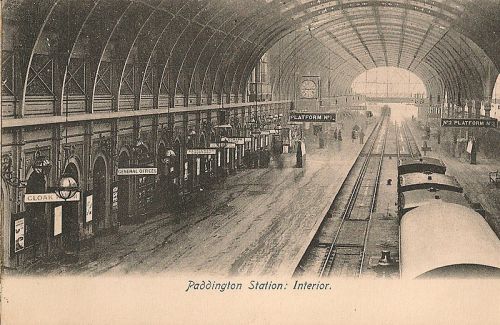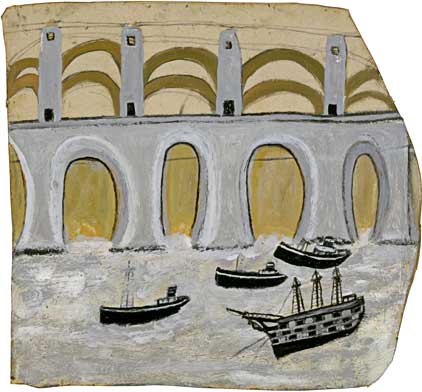Victorian image of Paddington Station, London
I like to think that there is a bartender in a certain Paddington station bar who passes the day in keen observation of the ever-changing ebb and flow of customers. Perhaps he is really a writer, or an actor honing his skills, but only he might notice that every six months or so, the same disparate group of men collects on the concourse – or ‘The Lawn’ as it is known – cluttering up the outside seating area with their rucksacks, and copious bags full of food and drink. And, sure enough, here they are again, ordering pints of Guinness at this breakfast hour… only this time there is something different. This time there is a woman with them, and she looks nervous…
There is a nauseating combination of cacophonous noise and busyness about Paddington that could easily jade the most diligent traveller. But with Brunel’s iron and glass roof forming a tunnel through which to shoot you to adventure and the west, there is still a romance that evokes the Victorian era of exploration and escapade. And I am so ready for adventure again after years of child-rearing. All the same, it’s hard not to feel apprehensive as I sit cradling my half-pint of Guinness, not really wanting it, but reluctant to betray my girlishness from the off. The boys have welcomed me on their Walk, and it wouldn’t do to complain that surely coffee would be more appropriate at this time of day before I’ve even set one booted foot upon an unmade path. And as if the early alcohol consumption wasn’t enough, I’m now being introduced to The Whip…
No, not that kind of whip, but rather that very British and democratic method of ensuring that one of the party does not always end up buying all the rounds, or in this case, all the drinks, meals, snacks, sundry train or bus fares, and any other miscellaneous costs. It’s quite simple: everyone contributes to The Whip, usually around twenty pounds each; and it is then used for all expenses until it runs out; at which point another twenty pounds is thrown in by each person, and so on. The money is placed, medieval-style, in a black velvet drawstring bag (I don’t ask), and everyone must take a turn, in other words, responsibility, for carrying it. I have mixed feelings about The Whip, as I sip at my little ‘half’, and watch the boys order their second pint; but reason that since I may make up for it by the evening – a much more natural tippling time for a wine drinker – that it may all even out in the end.
Andy has taken over as ‘Grand Poobah’ from Rod, who held this title by not previously missing a single walk, but due to personal circumstances, has had to cancel for the first time. Late, and in possession of the train tickets, Andy, with typical insouciance eventually saunters into view giving us just minutes to dash for the First Great Western. I had hoped for the Cornish Riviera Express, or at least something from Thomas the Tank Engine, but our train is disappointingly modern. We are headed to the far west of Cornwall, and little then did I know what an impression this journey would have on me for years to come. The suburbs and industrial hangers on the outskirts of London are swiftly left behind and before long we are hurtling through England’s green and pleasant vales of chalk white horses and mysterious burial mounds. The fields are bathed in glorious May sunshine, and the railway banks soon give way to beautiful yellow gorse; so close to the train that you could reach out and touch… much as I was used to instinctively touching the head of a small child. I inadvertently startle now and then, as though I have forgotten something. I am so used to always looking out for a little one, it is instinctive to keep checking, checking…but the guys are doing a fine job of distracting. Luckily, we have managed to book two adjoining table-seats in the centre of the carriage, and they are carefully and methodically arranging what looks like a small Roman feast. There is fresh bread, fruit, cheese and wine; olives, stuffed dates, pates and cooked meats… Jim has brought a pre-made flagon of some cocktail or other and is busy cutting fresh limes. Other passengers eye us with envy as they stumble back from the buffet car with malodorous burgers and Styrofoam-clad coffee. Any efforts at nonchalance soon give way to unrestrained grins of excitement as the dual intoxicating effects of wine and the hot sun on our heads relax us, and I am regaled (as is the entire carriage I suspect) with hilarious stories of past walks… but these are tales for another time.
Past Exmouth and it’s The Brunel Show all the way, as the train swings along the very edge of the English Channel for a brief but sensational sea-front ride. Cutting through the cliffs and along the sea wall, before lurching inland again towards Newton Abbot, The South Devon Railway was opened in 1846 and originally intended as an ‘atmospheric’ railway. But in less than a year the gauge was converted and it became part of the Great Western railway. Ever at risk from a breach of the sea or a land-slip (not to mention an errant wave) it may be something of an expensive folly, but I love Brunel’s imagination and audacity in building, against logistical reason or regard for maintenance, a line that enthralls. At least, that is, to those of us still stirred by that first childish glimpse of the sea. I have travelled this way many times now and am still befuddled at the number of passengers who pay no attention to this treat; who do not have their noses pressed to the window, but sit ensconced in technological absorption or enshrouding broadsheet, willing the long journey over.
To me, the five and a half-hour train ride to west Cornwall has become an important, integral part of my visits. And not just because I like trains, and people watching, and bucolic views; time traversed is a reminder of entering another country, another world. As if to emphasise this ritual, the train slows to a stately crawl as it passes over that other wonder of Brunel engineering, the Royal Albert Bridge. Naturally this is entirely to do with safety, and not to give those of us who care time to reflect on the River Tamar, dotted with tiny boats far below, and almost, but for three miles, separating Cornwall from England. Yet, in my fanciful mind there is something ceremonial in this passage, a respectful recognition of transition, a feeling compounded when there is just enough time to read the sign at Saltash on the western side of the river before the train picks up speed again: ‘Kernow a’gas dynnergh’. Welcome to Cornwall.
Boats under Saltash Bridge (Royal Albert Bridge) by St Ives artist Alfred Wallis
White horses give way to crumbling abandoned engine houses, those relics of the Cornish tin mining industry, and in time we arrive in St Erth, where we are due to change for the branch line to St Ives. St Erth is a very pretty brick-built station with a tea room, that has somehow managed to resist alteration since its 1877 construction, and already I know I’m in another place as a gentle summer breeze sways palm trees and unfamiliar early summer flowers. The St Ives branch line is a single track upon which the train carriages run the four miles back and forth to St Ives, and there is not long to wait for the next one. But no; there is, apparently time for a quick sprint to the nearby Lamb and Flag. Once again I cunningly hide my desire to preach sense, and go with the flow; fie thee prudence, I cast my fate to the wind! But the wine is taking its toll and my rucksack feels very heavy on my shoulders as I struggle to keep up the pace, which is presumably set at ‘beer’ mode. It does not bode well for the walk ahead.
Half an hour later, on the branch line train and lulled into a happy drowsiness, we roll past the Hayle estuary mudflats, home to many rare bird species. But as the river-mouth opens to the sea and the expanse of Porth Kidney Sands and the long stretch of beach to Gwithian and Godrevy lighthouse, we are startled to our feet again at the carriage window, silently captivated by the sublime beauty. This is one of the most beautiful train journeys in the country, but too quickly it passes by Hawkes point and Carbis Bay via clifftop and viaduct, before settling at journey’s end, overlooking Porthminster Beach at St Ives. This is the journey of a bygone age, reminiscent of beach huts, Betjemen and sand in the sandwiches. And then there is the first view of St Ives itself. No wonder the early railway posters advertised it as The Cornish Riviera.
Before long, we are sitting at a table outside the ancient Sloop Inn where we are staying, supping a pint of Doom, and watching the incoming tide gently slap against the harbour boats. In early May there are no crowds and I’m personally delighted by the abundance of handsome ruddy-faced locals in fisherman’s jumpers…
Later, at a harbour-front restaurant, the journey, or rather the alcohol consumption takes it toll, and I cannot eat the scrumptious mushroom fettucine or drink the delicious Viognier. All the weeks of preparation, the miles of hill-walking and becoming fit and hydrated for the walk ahead have been undone in a single day, and I dread the sixteen miles of steep cliffs that lie ahead in the morning. But as I bid goodnight to the guys and make my way back along the deserted wharf to my room, heady with the sea air, the black ocean beats more insistently against the harbour wall, and I know there is a connection with this place that will not easily be broken.
Next time: St Ives.
As part of a recent restoration project, Patrick Baty of Papers and Paints in London was asked to make a paint analysis in order to ascertain the original colour of the Royal Albert Bridge. You can read more about this here: http://patrickbaty.co.uk/2010/11/25/royal-albert-bridge-cornwall/




Lovely tale of the train journey I used to make quite often when I worked away form Cornwall through the eighties and early nineties. Especially coming over the bridge and knowing you weren’t far from home then. Ref. The Whip, when away on tour we used to call it "The Weasel" (as in Weasel and Stoat…..Float!)
Thanks for the feedback Mr Spanner! Yes I think our whip needs a better name…maybe not weasel though, it’s a nickname of one of the guys; rarely used but could get confusing!
What a wonderful piece! Beautifully written and so evocative of anticipating adventure.Just fancy a pint overlooking the harbour now. Sounds like a great trip.
Thanks Keatsbabe, it was! And not over yet… You must have a pint of Doom overlooking St Ives harbour at least once in your life; but be prepared to fall under a spell… (and avoid the summer crowds!). And thank you for picking up on the sense of adventure and exploration rediscovered x